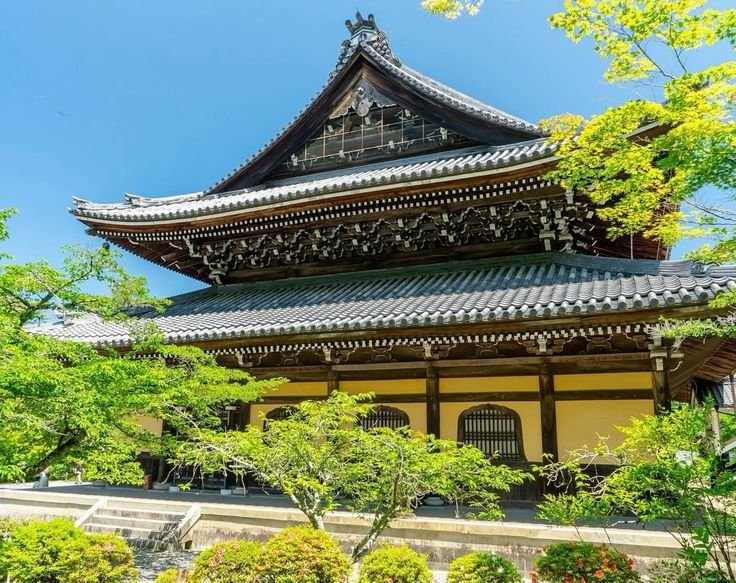
Nestled in a serene valley surrounded by forested hills in the Kansai region of Japan, Kyoto stands as a living archive of the country’s cultural, spiritual, and aesthetic traditions. Once the imperial capital of Japan for over a thousand years, Kyoto is often regarded as the soul of Japan—a place where ancient rituals and refined beauty converge in harmonious stillness.
In a rapidly modernizing world, Kyoto remains a sanctuary where time seems to slow down, inviting travelers to reflect, appreciate, and immerse themselves in its enduring customs. With over 1,600 Buddhist temples, 400 Shinto shrines, and countless zen gardens, teahouses, and machiya (traditional townhouses), Kyoto is not merely a city; it is an experience—a journey through history, nature, art, and mindfulness.
This is a city where cherry blossoms float through temple courtyards, where tea masters bow with graceful precision, and where the past is not forgotten, but cherished and celebrated in daily life.
A Legacy of Spiritual Splendor: Temples and Shrines
Kyoto is best known for its astonishing array of temples and shrines, each with its own unique story, architectural style, and spiritual purpose. These sacred sites are not relics; they remain active centers of worship and meditation, preserving centuries of spiritual devotion.
Kinkaku-ji: The Golden Pavilion
Perhaps the most iconic of Kyoto’s temples is Kinkaku-ji, or the Golden Pavilion. Originally built in the 14th century as a shogun’s retirement villa, it later became a Zen Buddhist temple. Its top two floors are covered entirely in gold leaf, creating a dazzling reflection in the still waters of its mirror pond. Surrounded by meticulously landscaped gardens, Kinkaku-ji is the epitome of harmony between architecture and nature.
Ginkaku-ji: The Silver Pavilion
On the opposite side of the city lies Ginkaku-ji, or the Silver Pavilion, another former villa turned Zen temple. Despite its name, the temple is not actually silver. Its understated elegance embodies wabi-sabi, the Japanese aesthetic that finds beauty in imperfection and transience. The surrounding gardens, particularly its white sand sea and moss garden, invite contemplation and introspection.
Fushimi Inari-taisha: Path of a Thousand Torii
Kyoto’s most visited shrine, Fushimi Inari-taisha, is dedicated to Inari, the Shinto god of rice and prosperity. It is famous for its thousands of vermillion torii gates, which form winding paths through the forested slopes of Mount Inari. Walking through these gates is a mesmerizing experience, as if stepping into a sacred tunnel that bridges the human and spiritual worlds.
Kiyomizu-dera: The Temple of Pure Water
Perched on a hillside overlooking the city, Kiyomizu-dera offers panoramic views of Kyoto, especially breathtaking during cherry blossom and autumn foliage seasons. Its wooden stage, supported by tall pillars and built without nails, is an architectural marvel. The temple’s Otowa Waterfall, whose three streams are said to grant longevity, success, and love, draws pilgrims and tourists alike.
These are just a few of the city’s most revered spiritual landmarks. Across Kyoto, from the Tofuku-ji Temple with its zen gardens to the Ryoan-ji Temple with its iconic rock garden, sacred spaces await those seeking tranquility, insight, and reverence.
Masterpieces of Nature: The Gardens of Kyoto
In Kyoto, gardens are not mere decorations; they are living expressions of philosophy and art. Influenced by Zen Buddhism, Shinto beliefs, and aesthetic principles, Kyoto’s gardens are crafted to evoke serenity, contemplation, and connection with the natural world.
Zen Rock Gardens
The karesansui, or dry landscape garden, is a uniquely Japanese form. At Ryoan-ji, the famed rock garden features 15 stones placed on a bed of white gravel raked in carefully maintained patterns. There is no “correct” interpretation of its meaning—it is a canvas for meditation, encouraging individual reflection.
Strolling Gardens
Other Kyoto gardens are designed for walking, revealing new views with each step. Katsura Imperial Villa is a masterpiece of such design, where pavilions, bridges, and tea houses unfold around a central pond, mirroring the aesthetic ideals of the Edo period.
Moss Gardens
At Saiho-ji, known as Koke-dera or the Moss Temple, over 120 species of moss create a lush green carpet that transforms the entire garden into a tranquil forest floor. Access requires a reservation and participation in a sutra-copying session, enhancing the spiritual significance of the visit.
These gardens are not passive scenery—they are immersive, contemplative, and intentionally designed to foster a deep appreciation of nature’s rhythms and textures.
The Way of Tea: Kyoto’s Enduring Tea Culture
No visit to Kyoto is complete without experiencing the traditional tea ceremony, known as chanoyu or sado—“the way of tea.” More than just the act of drinking tea, this ritual is a spiritual and aesthetic practice that embodies Japanese values of humility, respect, purity, and tranquility.
The Tea Ceremony
A Kyoto tea ceremony is typically held in a chashitsu (tea room), a simple, rustic space often surrounded by a garden. Every gesture, from bowing to whisking the matcha, is deliberate and mindful. The tea master serves guests with calm precision, using handmade utensils and seasonal wagashi (sweets).
Kyoto has been a center of tea culture since the 15th century, and it is closely associated with Sen no Rikyū, the most influential figure in the development of the tea ceremony. His legacy continues in institutions such as the Urasenke school, one of the main schools of tea still based in Kyoto.
Nishiki Market and Uji Tea
Tea culture also permeates everyday life in Kyoto. Stroll through Nishiki Market, and you’ll find shops selling high-quality matcha, hojicha (roasted green tea), and gyokuro. The nearby town of Uji, just south of Kyoto, is one of Japan’s most renowned tea-producing regions. Visitors can tour tea farms, participate in tastings, and learn about cultivation techniques passed down through generations.
Whether sipped in a serene tea house or enjoyed in a modern café as a matcha latte, tea remains a central thread in Kyoto’s cultural fabric.
Streets of the Past: Preserving Kyoto’s Historic Character
Much of Kyoto’s charm lies in its historic districts, where traditional machiya wooden townhouses line narrow lanes, and where the past feels alive with every step.
Gion: The Geisha District
Perhaps the most famous is Gion, Kyoto’s geisha district, where lantern-lit teahouses and cobblestone alleys preserve the ambiance of the Edo period. In the evening, you may catch a glimpse of a maiko (apprentice geisha) in full traditional attire, gracefully making her way to an engagement.
These women are highly trained artists, practicing music, dance, and refined conversation. Attending a geisha performance or private dinner is a rare and special experience that offers a glimpse into a world few outsiders truly understand.
Higashiyama and Arashiyama
Other historic districts like Higashiyama, home to Kiyomizu-dera, and Arashiyama, known for its bamboo groves and river views, provide immersive cultural walks through streets lined with artisan shops, pottery studios, and sweet shops. Here, you can rent a kimono, enjoy a traditional meal, and feel a part of Kyoto’s living history.
Festivals and Seasonal Beauty
Kyoto celebrates each season with grace and grandeur. From the sakura (cherry blossom) bloom in April to the fiery momiji (autumn leaves) of November, the city’s landscape changes like a carefully choreographed performance.
Gion Matsuri
Held in July, the Gion Matsuri is one of Japan’s most famous festivals. Dating back over a thousand years, it features elaborate floats, traditional music, and processions that bring Kyoto’s streets alive with color and celebration.
Hanami and Momijigari
In spring, locals and tourists alike gather under the cherry trees for hanami (flower viewing), while autumn brings momijigari (maple leaf hunting)—both times when the beauty of nature is deeply appreciated through festivals, food, and community gatherings.
A City That Balances Past and Present
Though steeped in tradition, Kyoto is not frozen in time. Modern Kyoto is home to world-class universities, innovative design studios, and a thriving culinary scene that includes both Michelin-starred kaiseki restaurants and hip coffee roasters.
The city’s ability to balance innovation with preservation is a model for urban development worldwide. Its artisans still practice centuries-old crafts, yet collaborate with contemporary designers. Its temples use digital technology to educate visitors, while remaining spaces for spiritual solitude.
Conclusion: Timeless Beauty, Enduring Spirit
Kyoto is more than a destination—it is an experience of grace, mindfulness, and quiet power. It invites you to slow down, listen, and appreciate the subtleties that make life beautiful. In its temples, you find serenity; in its gardens, clarity; in its tea houses, harmony.
This is a city where tradition is not a relic, but a living, breathing way of life. Kyoto continues to inspire and guide not by resisting change, but by embracing it with reverence and wisdom.
In Kyoto, the soul of Japan is not only remembered—it is lived, every day.




